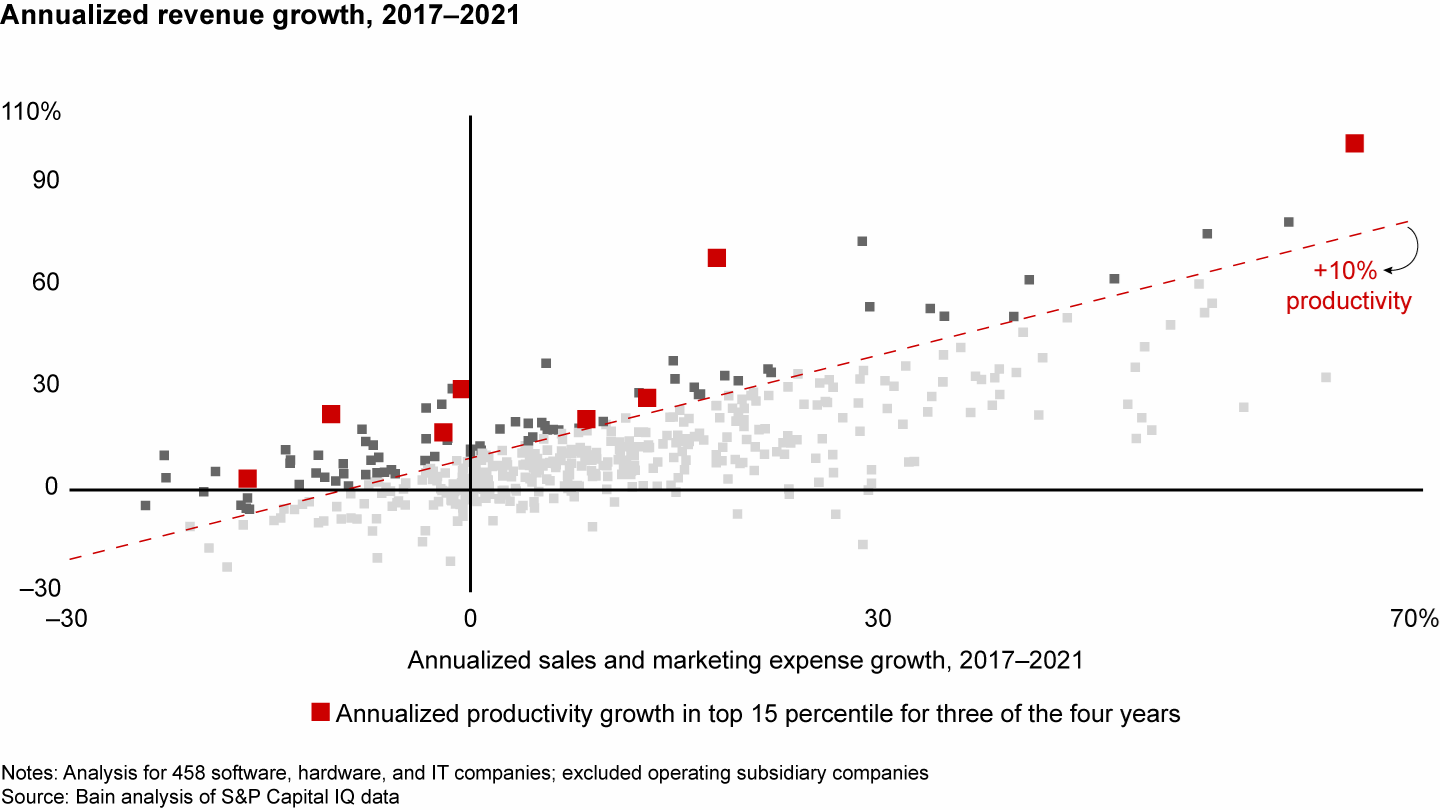Technology Report

Executive Summary
- With sales and marketing being a major operating expense in the tech sector, companies with growth aspirations need to raise and sustain their commercial productivity.
- Bain research on 1,254 companies worldwide from 2017 through 2021 found that the average company had flat productivity in any given year, but 5% of the firms realized productivity gains in at least three of the four years.
- These productivity leaders do things differently than the rest of the pack with their go-to-market model, support for sales reps, and efficiencies in sales and marketing support.
- Leaders also organize for productivity by assigning a clear executive owner and tying targets into their planning cadence.
This article is part of Bain's 2023 Technology Report.
Software, hardware, and other technology companies have found themselves in a tough position for most of 2023. After the recent years of rapid growth in which they felt free to add sales and marketing capacity, the economic tailwinds died down, stranding the tech sector in the doldrums. To placate investors and reset, many companies announced major layoffs and other cost-cutting measures.
But cost-cutting alone isn’t a viable response. Sales and marketing executives still aspire to grow the business, and they realize there’s no longer an option of adding capacity at a high cost. Their go-to-market model must become much more productive.
To that end, we recently focused our research on commercial productivity, which measures the revenue (or gross profit) returned per dollar of commercial cost, and then evaluates how much faster revenue grows relative to growth in sales and marketing expenses. Given that in software and some other tech sectors the largest operating expenditure typically is sales and marketing spending, greater commercial productivity is essential to survive, not just thrive.
As described in this Harvard Business Review article, we analyzed 1,254 public business-to-business companies worldwide from 2017 through 2021. The average company had flat commercial productivity in any given year, with revenue growing at the same rate as sales and marketing expenses. Some 19% of companies improved commercial productivity more than 10% in any given year, but most eventually dealt it back. Only 5% of companies were able to realize commercial productivity gains in three out of the four years (see Figure 1).
An elite group of companies have consistently improved commercial productivity


These elite companies—the sustained productivity leaders—achieved a meaningfully higher annual total shareholder return than their peers, with a 12% difference, on average.
The Harvard Business Review article describes how, over a period of years, commercial productivity leaders systematically pursue levers in three areas:
- They refine their go-to-market model. The leaders assess how to deploy sales and marketing capacity against the opportunities that will generate the highest returns. This involves rebalancing account assignments based on customers’ expected future spending, creating the most suitable territories for each seller.
- They turn every sales rep into an elite player. One tactic is creating data-informed sales plays—that is, a coordinated set of activities with target accounts. Another is consistent coaching to improve both rookie and veteran performance. And a third is creating a revenue intelligence database to guide reps on the most effective use of their time.
- They identify efficiencies in sales and marketing support. The leaders use automation tools to simplify processes, improve the accuracy of quotas for individual reps, reduce spans and layers in the organization, and scrutinize non-selling and non–quota-carrying roles.
There’s an organizational dimension to the productivity leaders as well. They assign a clear owner of commercial productivity, often with a dedicated role. Veteran leaders tie productivity targets into annual and multiyear planning so that the effort expands beyond the sales group. Many enlist a commercial operations team for modeling sales and marketing capacity, communicating with the finance group, and creating go-to-market blueprints that are continually revised.
Instead of commercial leaders making reflexive cuts or referring to last year’s levels, a commercial productivity framework allows them to make healthy trade-offs between top-line and cost savings actions. That perspective serves them well at any stage of the economic cycle.